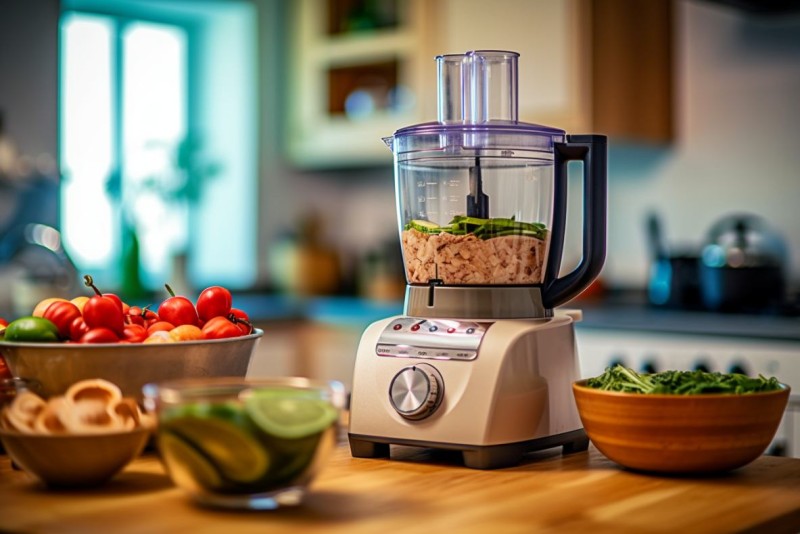Cooking can be a daunting task, especially when you have to chop, slice, and dice your ingredients. However, with the help of kitchen machines such as the food processor, meal preparations can be done easily and quickly.
This article will provide you with tips on how to efficiently use your food processor.
What is a Food Processor?
A food processor is an electric kitchen appliance that is designed to help you with food preparation tasks such as chopping, slicing, shredding, pureeing, and mixing.
The machine consists of a motorized base upon which different attachments are placed depending on the task at hand. It has a bowl where the ingredients are placed before they are processed.
Why Use A Food Processor?
Using a food processor can save you time and effort while ensuring that your meals are consistent in texture. It’s also an excellent way to cut down on kitchen waste by using up leftover ingredients or processing whole foods into smaller pieces for storage in the fridge or freezer.
Additionally, it can help you expand your cooking skills by allowing you to make recipes that would otherwise be too labor-intensive or time-consuming without it.
Choosing the Right Food Processor
When it comes to choosing a food processor, there are two main types available in the market, which are mini or compact food processors and full-size food processors.
Mini or compact food processors are typically designed for small jobs such as chopping nuts, and herbs, or making small batches of sauces and dips.
On the other hand, full-size food processors can handle more significant tasks such as kneading dough and shredding vegetables.
Factors To Consider When Choosing A Food Processor
When you're shopping for a food processor, several factors need to be considered to ensure that you pick the right one that meets your needs.
One of the crucial factors is size – how much counter space do you have? Consider purchasing a compact or mini if you have limited space. If not limited to space, bigger models are more powerful and versatile.
Another factor to consider is capacity; ensure it has enough capacity for your specific needs. Some models with smaller capacities may not be ideal if preparing larger batches of ingredients.
Before settling on any particular model, you should also think about what kind of cooking you will use it for. If you enjoy baking bread or pizza crusts frequently then kneading bowl capacity should be considered when selecting an appliance for that task.
Another factor is motor power; how strong should it be? You want enough power to handle tough tasks like shredding cheese without bogging down.
Durability is another vital aspect since we all want appliances that last long; hence check out reviews from past buyers so that you can get insight into their experiences with different brands/models.
Take note of any extra features like different blades and accessories included with each model since they could offer added value. By taking these various factors into account when selecting a model to buy will enable one to make an informed choice.
Preparing Food for Processing
Cleaning and Drying Fruits and Vegetables
Before processing any fruits or vegetables, it is important to ensure that they are thoroughly cleaned and dried. This helps to remove any dirt, bacteria, or residual pesticides that may be present on the produce. Start by rinsing the fruits and vegetables under cold running water to remove any visible dirt or debris.
Then gently scrub them with a brush or sponge to remove any stubborn stains. Once clean, pat the produce dry with a clean towel or paper towel.
Cutting Ingredients into Small Pieces
When working with a food processor, it is important to cut all ingredients into small pieces before adding them to the machine. This helps to ensure that the ingredients are processed evenly and can also prevent damage to the machine's blades.
When chopping vegetables, aim for uniform pieces that are roughly the same size so they can all be processed at once.
Preparing Ingredients Before Placing Them in The Food Processor
Some ingredients may require additional preparation before they can be added to your food processor. For example, nuts may need to be toasted first or soaked overnight before being blended into a smooth paste.
Additionally, some foods like hard cheeses need to be grated by hand before processing them in a food processor. By taking these extra steps when preparing your ingredients you'll help ensure optimal results from your food processor every time you use it.
Using the Food Processor Properly
To get the most out of your food processor, it's important to use it properly. Here are some tips to help you use your food processor efficiently:
Assembling and Disassembling the Machine
Before using your food processor for the first time, be sure to read the instruction manual and familiarize yourself with its parts. Assemble the machine according to the instructions provided.
When you're done using it, disassemble it and clean all parts carefully. Be sure to dry each part thoroughly before storing it away.
Understanding the Different Blades and Attachments
Your food processor may come with several blades and attachments designed for specific tasks such as slicing, shredding, or kneading dough. It's important to know which blade or attachment to use for each task so that you can achieve desired results while avoiding damaging your appliance.
For example, if you want thin slices of vegetables or fruits like cucumbers or apples for salads or garnishes, use a slicing disc rather than a grating one.
Avoiding Overfilling or Underfilling
When processing ingredients in your food processor, don't overfill the bowl beyond its capacity as this may cause an uneven chop or even damage your machine's motor.
It's better to process ingredients in batches if necessary than risk overloading your machine by trying to fit everything at once.
You should also avoid under-filling since this may lead to poor results when processing small amounts of ingredients that need more space in contact with blades.
“I like to use my food processor in smaller batches. As the first batch is going, I will start preparing the next batch. It’s a lot easier to maintain the ingredients when the food processor doesn’t get too filled.” - Ron Scott, Carnivorous Life.
Recipes that Can Be Made with a Food Processor
Homemade Nut Butter
One of the most delicious and healthy things you can make with a food processor is homemade nut butter. To make it, simply place your favorite nuts in the food processor and process them until they turn into a smooth paste.
You can add some honey, sea salt, or vanilla extract for flavor. There are so many varieties of nut butter you can make, such as almond butter, cashew butter, and peanut butter.
Hummus and other dips
Hummus is another popular recipe that you can easily make in your food processor. Hummus is a thick paste made from chickpeas, tahini, lemon juice, and garlic. To make hummus in your food processor, simply add all the ingredients into it and process until smooth and creamy.
You can also experiment with different flavors by adding ingredients like roasted red pepper or sun-dried tomato. In addition to hummus, other dips like Baba Ghanoush (smoky eggplant dip), Tzatziki (Greek yogurt dip), and Spinach-Artichoke Dip could be done quickly using a food processor.
Soups, Sauces, Dressings & Marinades
A food processor also comes in handy when making soups, sauces dressings, or marinades. For example, when making soups, chop up raw vegetables such as carrots or onions into small pieces using the food processor before adding them to the soup pot.
This greatly reduces cooking time while maintaining nutrition. For dressings & marinades just blend fresh herbs, salt, oil, vinegar, mustard, and honey with a few pulses of the blade to get your dressing ready.
Sauces like pesto sauce made from fresh basil leaves, pine nuts, oil, and parmesan cheese, can also be done in a food processor. The options are endless with a food processor, experiment with different combinations to create your favorite recipes!
Cleaning and Maintaining Your Food Processor
Cleaning After Every Use
Cleaning your food processor after every use is extremely important to ensure that it remains in good working condition. Begin by unplugging the machine and carefully disassembling it, making sure to remove all blades and attachments.
Wash them in hot soapy water, using a sponge or brush to scrub away any leftover food particles. Rinse thoroughly and dry completely before storing.
Taking Care of Blades
The blades of your food processor are the most important part of the machine, as they do all the chopping, grinding, and processing of your ingredients. To keep them in good condition, avoid putting them in the dishwasher as this can cause rusting or dullness.
Instead, wash them carefully by hand and dry them thoroughly before storing them. You can also sharpen your blades periodically using a sharpening stone or honing steel.
Storing Your Food Processor
Proper storage is essential for maintaining your food processor's longevity. Make sure to store all components together in a clean and dry location that is easily accessible when you need it next time. Keep it away from direct sunlight or heat sources that can damage its electrical components over time.
It's also important to cover the machine with a dust cover or towel to protect it from dust buildup when not in use. Maintaining your food processor is relatively simple but critical for keeping it working efficiently for years to come.
In Summary
By following these tips for using a food processor, you can make the most out of this versatile kitchen appliance. Choosing the right food processor, preparing ingredients properly, and understanding how to use your machine can help you achieve great results in your cooking.
You can also experiment with different recipes to take your cooking to the next level. However, it is important to remember that taking care of your machine is crucial for its longevity.
Do not forget to clean it after every use and store it properly. By following these tips and taking good care of your food processor, you will be able to enjoy this useful kitchen tool for years to come.









